Observational FactsRegarding the Joint Activitiesof the Southwest Vortex and Plateau Vortex after ItsDeparture from the Tibetan Plateau
2016-08-12ShuhuaYUWenliangGAODixiangXIAOandJunPENG
Shuhua YU,Wenliang GAO,Dixiang XIAO,and Jun PENG
1Institute ofPlateau Meteorology,China MeteorologicalAdministration,Chengdu 610072
2Ya’an MeteorologicalBureau,Ya’an 625000
3Sichuan MeteorologicalObservatory,Chengdu 610072
Observational FactsRegarding the Joint Activitiesof the Southwest Vortex and Plateau Vortex after ItsDeparture from the Tibetan Plateau
Shuhua YU∗1,Wenliang GAO2,Dixiang XIAO3,and Jun PENG1
1Institute ofPlateau Meteorology,China MeteorologicalAdministration,Chengdu 610072
2Ya’an MeteorologicalBureau,Ya’an 625000
3Sichuan MeteorologicalObservatory,Chengdu 610072
Using atmospheric observational data from 1998 to 2013,station rainfall data,TRMM(Tropical Rainfall Measuring Mission)data,aswellasannualstatistics for theplateau vortex and shear line,the jointactivity featuresofsustained departure plateau vortexes(SDPVs)and southwest vortexes(SWVs)are analyzed.Some new and useful observational facts and understanding are obtained about the jointactivities of the two types of vortex.The results show that:(1)The jointactive period of the two vortexes is from May to August,andmostly in June and July.(2)The SDPVs of the partnershipmainly originate near Zaduo,while the SWVs come from Jiulong.(3)Mostof the two vortexesmove in almost the same direction, moving eastward togetherwith the low trough.The SDPVsmainly actin thearea to thenorth of the YangtzeRiver,while the SWVsare situated across the YangtzeRivervalley.(4)The jointactivity of the two vortexesoften producessustained regional heavy rainfall to the south of the Yellow River,influencing w ide areas of China,and even as far as the Korean Peninsula, Japan and Vietnam.(5)Mostof the two vortexesarebaroclinic or cold vortexes,and they both becomestrengthened in terms of their jointactivity.(6)When the two vortexesmoveover thesea,their centralpressuredescendsand their rainfallincreases, especially for SWVs.(7)The two vortexesmightspin over the samearea simultaneouslywhen thereare tropical cyclones in the eastern and southern seasof China,ormove southward together if a tropical cyclone appearsnear Hainan Island.
plateau vortex,southwestvortex,observationalstudy
1. Introduction
The Tibetan Plateau vortex(TPV)and southwest vortex (SWV)aregenerated under the dynamic and thermodynamic actionsof the unique complex terrain of the Tibetan Plateau. The TPV forms over themain body of the Tibetan Plateau and ismainly active on the 500 hPa isobaric surface.Ye and Gao(1979)described the horizontal scale of the TPV to be around 500 km and the vertical thickness as ranging w ithin 2–3 km approximately.The SWV,meanwhile,usually occurs on the southeastside of the Tibetan Plateau and in the southwestern partof China,mainly active on the 700 hPa isobaric surface.As documented by Lu(1986),the SWV is a shallow and thinmesoscale system w ith a scale of 300–500 km, observedmainly on the isobaric surface at700 hPa.
The TPV is generated in thewestern partof the Tibetan Plateau and dies away in the eastern part.Some TPVs can move out of the plateau,bringing rainstorms,some severe, to extensive regions of China and even resulting in flooding disasters(Tao and Ding,1981;Zhang etal.,2001;Yu etal., 2014).Most SWVs form and then disappear in their source region(Chen etal.,2007b),butsomew ill leave their source areas,w ith substantial impacts on precipitation over China (Lu,1986;Kuo etal.,1988;Chen etal.,2003).
The study of these vortex phenomena(i.e.,TPVs and SWVs)has attracted much attention from meteorologists, both domestically and internationally(e.g.,Qian etal.,1984; Chen,1990;Li et al.,1991;Luo,1992;Gao,1987;Wang, 1987;Chang etal.,2000;Chen etal.,2000;Wang and Gao, 2003).In recentdecades,increasing concern hasbeen placed on the study of TPVs that shifteastward outof the plateau; specifically,theunderlyingmechanism involved in theireastwardmovement.Yu and Gao(2009)pointed out that the departure of the TPV from the Tibetan Plateau is caused by the interactionof thewesterlies,subtropicalweathersystems, and theweathersystemsof theupper levelof the troposphere. Li et al.(2011)concluded that TPVs may contain vortex Rossby waves and inertial-shallow gravity waves.He et al. (2009)found that the interaction of cold andwarm air causesthe convergent flow field to be sustained and strengthened, which isa criticalelement for themaintenanceand intensification of the vortexes.Furthermore,Yu etal.(2008)pointed out that under the condition of reinforced baroclinic instability,the TPV tends to move out of the Tibetan Plateau. Song etal.(2012)suggested that the latentheat of condensation and water vapor plays vital roles in themaintenance of a vortex and the evolution of its structural features.Takahashi(2003)concluded thatcold airdirectly impactsupon the developmentof the low pressure in the northern partof the plateau.In comparison,w ith respect to research on SWVs, scientists have beenmore concerned w ith studying their dynamicsand numericalsimulation.Chenetal.(2007c)derived three-dimensional vorticity change equations and analyzed the impactofatmospheric stratification and itschangeson the change in three-dimensional vorticity.Using numerical simulation,Chen etal.(2004)found thatas the vortex strengthens,the phenomenon of frontogenesis,in theeastward direction,is clear.Zhou et al.(2006)revealed that the northeast airflow of Typhoon Songda blew into the southeast side of the SWV,triggering an extremely severe rainfallevent.Chen etal.(2007a)indicated that the large-scale circulation of the“saddle pattern”is conducive to the developmentofan SWV. Other researchershavealso pointed outthebasic factsand activity featuresof TPV(Yu and Gao,2006;Wang etal.,2009) and SWV(Chen and Min,1999;Chen etal.,2007b)activity.
Research on TPVsand SWVshas thus far focusedmainly on one of these two types of vortexes.Whilst these studies have revealedmany importantand interesting factsabout the two kindsofvortexes,therehasbeen little recognitionof their joint activities and changes,which have significant impacts on theoccurrenceof severe precipitation overChinaand East Asia.Addressing this know ledge gap is therefore of great significance,not only to further our understanding of their interaction,butalso to realize the relationship of these joint characteristicsw ith severe precipitation in China,to improve forecasting technology,and to ultimately reduce thedamages caused by the associated rainstorms.In addition,a reliable basis can be formed for studying the eastward movement, developmentand impactmechanisms of the TPV and SWV. Therefore,itisnecessary to use the latestdata to carry out research on thedominantactivity and variation of thevortexes’jointactivities,aswellas their impacts on precipitation over China.
This paper aims to reveal the joint activity characteristics of TPVs with amore than 2 day lifetime after departing the plateau(SDPV)and SWVs.Furthermore,the respective characteristicsof an SDPV w ithin the jointactivity of an SDPV and SWV(TVSPDV)and thatof an SWV w ithin the jointactivity of an SDPV and SWV(TVSWV)are discussed in detail.
The remainder of the paper is organized as follows:The dataandmethodsare introduced in section 2.The TVSPDVs and TVSWVsare analyzed in section 3 in termsof their active years andmonths,paths and seedbeds.The variabilities of the TVSPDVs and TVSWVs are analyzed in section 4. The differencesbetween TVSPDVsand SDPVsand the differences between TVSWVs and SWVsare compared in detail in section 5.And lastly,the conclusionsof the study are given in section 6.
2. Data andmethods
2.1. Data
Four datasets are used in this paper.The fi rst includes geopotential height,temperature,w ind direction and w ind speed at500 hPa,and thedataarebased on tw ice-daily observations(1998–2013)from 120 radiosonde stations.The second comprises the 24-h accumulated rainfall collected from 1244 nationalmeteorological stations from 1998 to 2013, w ith quality control applied by the NationalMeteorological Information Centerof the ChinaMeteorological Adm inistration(CMA).The third is the statistics from the Yearbook of the TPV and the shear line,again from 1998 to 2013,published by theChengdu Instituteof PlateauMeteorology of the CMA.And the fourth datasetis the TropicalRainfallMeasuring Mission(TRMM)data from the Goddard Earth Science Data and Information ServicesCenter,National Aeronautics and Space Administration(NASA),United States of America.
2.2. Methods
Using synoptic and statistical analysismethods,the different processes of SDPVs that accompanied SWVs are investigated and analyzed in thispaper.
First,an SPDV is demarcated as a low pressure system w ith closed isoheight or a vortex w ith cyclonic w inds,at threeadjacentstationsat500 hPa,generated over the Tibetan Plateau,w ith a longer than 2-day lifetime after departing the plateau.A TVSPDV is an SDPV thatpossesses jointactivity w ith an SWV.By contrast,a DPV is a departure plateau vortex.
Second,an SWV is demarcated as a low pressure system with closed isoheight or a vortex w ith cyclonic w inds, at three adjacentstations,at700 hPa,generated over the leeward slope(26°–33°N,99°–109°E)of the Tibetan Plateau. A TVSWV is an SWV that possesses joint activity w ith an SDPV.
According to their areas of origin,SWVs can be divided into the Jiulong vortexes,the Sichuan Basin vortexes (basin vortexes for short)and the Xiaojin vortexes(Institute of Plateau Meteorology,China Meteorological Adm inistration,Chengdu,and Plateau Meteorology Committee of ChineseMeteorological Society,2013).
Third,the TVSDPVs(TVSWVs)are sorted into three groups according to their activities:thewarm,the cold,and the baroclinic,based on the temperature distribution of the vortexeson the 500 hPa(700 hPa)synopticmap.If a vortex is situated in the warm spine at 500 hPa(700 hPa)w ithout cold air incursion,it is categorized asawarm vortex.However,avortex iscategorized asbaroclinic if itisswarmed into the cold air obviously,regardless of its location in thewarm trough or the frontalzone.The cold,of course,indicates thatthe vortex exists in the cold environmententirely(Yu etal., 2014).The cold orwarm vortexesarebarotropic.
Fourth,the rainy area of a TVSDPV or TVSWV is determ ined by both the vortex circum fluence range and the observed rainfalldistribution,including the rainfall incurred by three SDPV,SWV and synoptic systems,which are hard to distinguish.
The identifi cation of continuously regional rainstorms, the interceptionofprecipitation areasimpacted by TVSDPVs and TVSWVs,and the distinction between the plateau’seast and west vortexes aremade using themethods described by Yu etal.(2014).
Finally,based on the definitions above,all of the TVSPDVsand TVSWVsthatoccurred during1998–2013are identified and studied.
3. Activities of TVSPDVs and TVSWVs during 1998–2013
The active period,origins and paths of TVSPDVs and TVSWVsduring 1998–2013 are analyzed in detailhere.
3.1. Active period
Figure1 shows the totalnumberof SDPVsand TVSWVs in each year and each month over 1998–2013.As shown, the highestnumber is in 2013,w ith a totalof five(Fig.1a). Such jointactivities in 2013 contributed greatly to the floods in the Yangtze River valley,Yellow River and Huaihe River aswellas the Sichuan Basin,which indicates thatSDPV processes joined by SWV activities have significant impacts on thew idespread occurrence of summer flooding in China.In comparison,2012 has the fewestSDPVs,with none recorded (Fig.1a).The figure also shows that during the 16 years, 63%of SDPV processes are accompanied by SWV activities.Generally,if there aremore(fewer)SDPV processes in ayear,more(fewer)accompanying SWV activitiesappear accordingly(Fig.1a).This suggests that the joint activity features of SDPVs and SWVs are highly prom inent.In addition,we see that the fi rst two-vortex jointactivity process appearsin early March and the lastisin lateOctober,and that such jointactivitiesmainly take place from May to August, ofwhich July is themonth w ith themost cases,followed by June.Therefore,the two-vortex jointactivity process is primarily seen from June to July(Fig.1b)—different from the activities of SDPVs,whichmainly occur from June to August(Yu etal.,2014),and also different from the sim ilar occurrencenumberof DPVs from June to August(Yu and Gao, 2006).Moreover,TVSWVs,whicharedifferent from SWVs, mainly occur from April to July,butthe frequency is thehighest in Apriland June(Chen etal.,2007b).
3.2. Origins
Figure 2 shows the starting places of TVSPDVs from the 16-yr statistics.The shading in Fig.2 represents the Tibetan Plateau.The serialnumbersof TVSPDVs aremarked.

Fig.1.The(a)annualand(b)monthly appearance numbersof SDPVs(black) and TVSWVs(red)from 1998 to 2013.
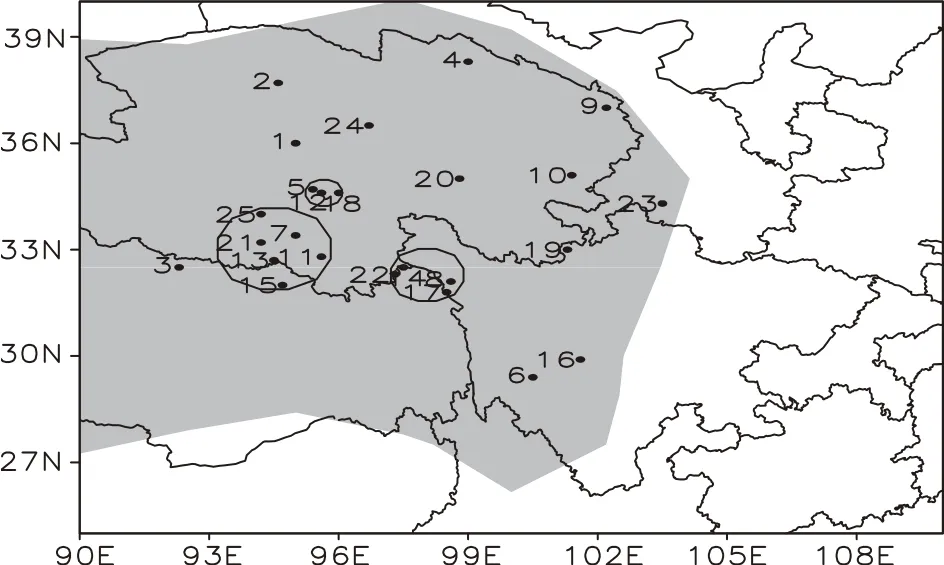
Fig.2.The origins of TVSPDVs during 1998–2013.The sequential numbers indicate the movement order of TVSPDVs and the circles indicate the regions w ith concentrated occurrence(two ormore)of TVSPDVs.Theshaded area is the region w ith altitudehigher than 2500m.
The circle implies that two ormore TVSPDVshaveoccurred w ithin the enclosed area.Obviously,most TVSPDVs form in the eastern portion of the Tibetan Plateau,especially in Zaduo,Yushuand Quma,butnotin Qumalaiand Degewhere DPVs form(Yu and Gao,2006).This is also different from the frequency distribution of SDPVs,which lies primarily near Qumalai,and secondarily,near Yushu,Zaduo and Aba (Yu et al.,2014).All these phenomena reflect the fact that TVSPDVshave differentsources to DPVsand SDPVs.
The origins of TVSWVs from 1998 to 2013 are exhibited in Fig.3.It is shown that,during the 16-yr period,Jiulong vortexes and basin vortexes are themainmembers of TVSWVs;each of them account for 41%of the total,while the Xiaojin vortexes account for 18%only.For the Jiulong and basin vortexes,their origins aremostly in Jiulong,and then nearDaocheng,Quxian,Tongnan,Tongjiang,Dianjiang and Huili.This finding isdifferent from theanalysisof Chen et al.(2007b),that themain two generation centers lie near Jiulong and Santai,reflecting the origin of TVSWVs is different from that of SWVs.In addition,Fig.3 also shows thatmostTVSWVsaregenerated beforeTVSPDVsmoveout of the Tibetan Plateau,and the particularly prom inentvortex type is the Jiulong Vortex,accounting for75%.
Theoriginsof the TVSPDVsare concentrated in theeastern part of the plateau.This is possibly because there are fewer radiosonde stations in thewestern partof the plateau, and thus thereare fewer related data.Therefore,it isdifficult to verifywhetherornot TVSPDVs tend to originate from the western partof the plateau.
3.3. Paths
Statistical data show that 4/5,or 80%,of TVSPDVs in the16-yrperiodmove to north of the YangtzeRiver.Figure4 shows thatmostTVSPDVsmove eastward ornortheastward, some southeastward fi rst,and then turn to the southwest,or southeastward fi rst,and finally to the northeast.Such paths are different from the pathsof SDPVs,mostofwhichmove eastward or northeastward(Yu et al.,2014).Therefore,the typicalmovement path of TVSPDVs ismore complex than thatof SDPVs,whichmay be caused by the interaction between SDPVsand SWVs.
Themovementpaths of TVSWVs during 1998–2013 are essentially in the Yangtze River valley,accounting for 2/3 or 67%.The vastmajority of TVSWV movementpaths are to thesouthof thepathsof TVSPDVs,accounting for89%.Figure 4 reveals that,in the last 16 years,most TVSWVs have moved northeastward or eastward.This finding is different to thatof SWVs,formostof these quickly dissipate in their sourceareasand only a smallnumbermove outof theirgeneration regions(Chen etal.,2007b).
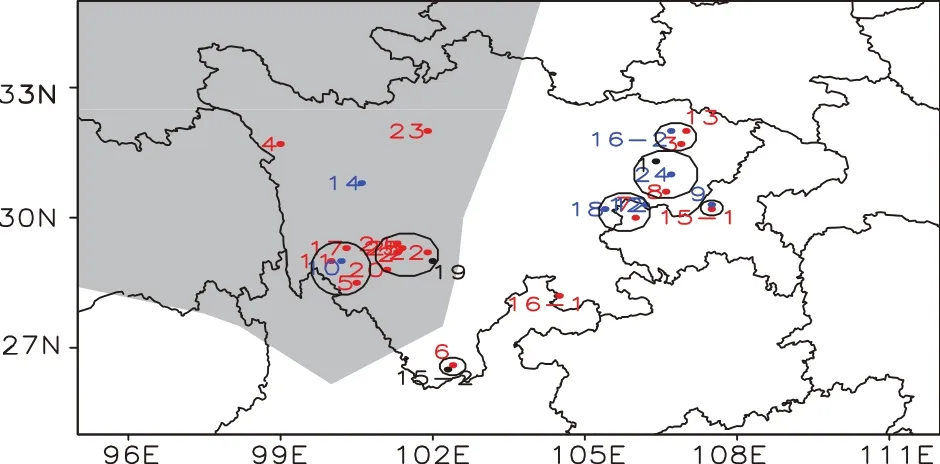
Fig.3.The origins of TVSWVs during 1998–2013.The sequentialnumbers indicate themovementorderof TVSWVsand the circles indicate the regions w ith concentrated occurrence (two ormore)of TVSWVs.The red,blue and black numbers represent the SWVs before,at the pointof,and after the SDPV movesoutof the Tibetan Plateau.The shading is the sameas in Fig.2.
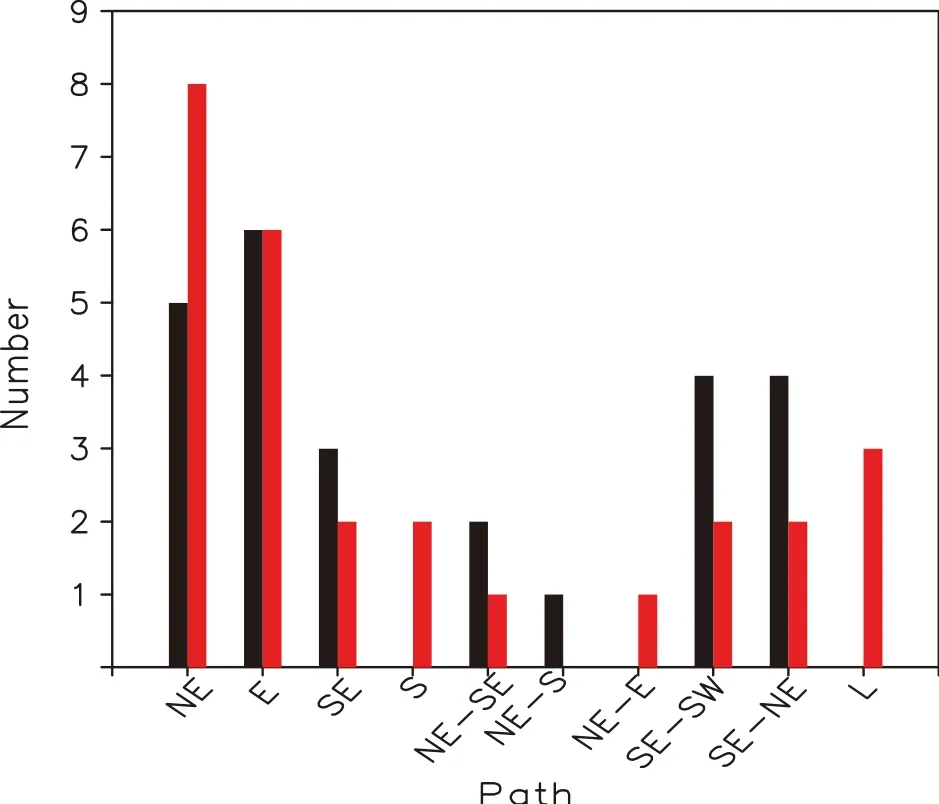
Fig.4.The frequency of different movement paths of TVSPDVs(black)and TVSWVs(red)from 1998 to 2013.NE means northeastward;the dash between two letters,e.g.,NE–SE,signifies a veer.Lmeans lessmovementor dissipating in situ.
By analyzing themovementdirections of TVSPDVsand TVSWVs during 1998–2013(table om itted),it is found that in most cases the TVSPDVs and TVSWVsmove in similar directions,gradually,or in the same direction during thesame activity process,especially during long-lasting activity processes(longer than 84 h)after the TPV departs from the plateau.This phenomenon reflects the fact that it is clearly noticeable that TVSPDVs and TVSWVs usually move together during their common activity processes.
3.4. Active stages
Figure 5 shows the different active stage numbers of TVSPDVs and TVSWVs from 1998 to 2013.It is shown that72%of TVSPDVs survive for 48–72 h and the longest for 144 h.This is different from SPDVs,whose percentage of active stagesafter they leave the plateau is61%(48–72 h) and the longest duration is 192 h(Yu etal.,2014).In contrast,the active stages of TVSWVs last for 36–72 h(56%), and only a small number of the vortexes live for 96–108 h, and the longest for 156 h.This finding is different from the SWVs,for 75%of the vortexesdie away in 1–24 h(Chen et al.,2007b).Besides,analysisalso shows that it ismainly the Jiulong vortexes thatcan sustain for60–96 h and 108–144 h, which together account for 56%.The secondary type is the basin vortex,which can last for60–96 h(37%)and 108–144 h(29%).In addition,the basin vortex is a TVSWV,which has the longestactive stage(156 h).This phenomenon indicates that,in the case of TVSWVs,more attention should be paid to the activity of Jiulong vortexes and,meanwhile,the basin vortexesshould also be closelymonitored.
4. Variability of TVSPDVsand TVSWVs
Theabove factsindicate thatTVSPDVsand TVSWVsare differentinmany aspects,such as theiractive period,origins, paths,and active stages.Next,we exam ine the variability of TVSPDVs and TVSWVs in terms of their intensity,properties,precipitation and relatedmovementpath,aswellas their interactionw ith other synopticweather systems.
4.1. Variations of TVSPDVs and TVSWVs during their lifetime
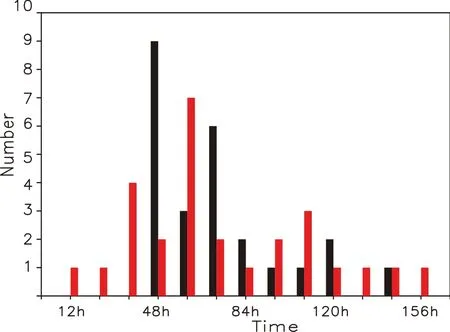
Fig.5.The frequency of different active stages of TVSPDVs (black)and TVSWVs(red)from 1998 to 2013.
By analyzing the thermodynam ic characteristics of TVSPDVs in the 16-yr period at the beginning of departure and their lifetime after departing the plateau(Table 1), two key results are found,as follows:(1)The lifetime of a TVSPDV aftermoving outof the plateau is,to some extent, related to its thermodynam ic properties.The TVSPDVs,w ith a lifetime of 48 h,are often of baroclinic nature or cold,and those surviving for 60 h aftermoving outof the plateau are mostly cold,accounting for67%.Thismeans that the impact of cold airon TVSPDVs ismoreobvious than on TPVs,after theirmoving outof the plateau(Yu and Gao,2006).(2)Most TVSPDVsexperience lowered geopotentialheightduring the lifetimeafter they depart from theplateau,compared toatthe beginning of their departure,especially for those persisting longer than 108 h,all ofwhich are declining.This is different from the drop in geopotentialheightof SPDVs lasting for 72–96 h,after they have left the plateau(Yu etal.,2014).
Table 2 compares the characteristics of TVSWVswhen and after they drift outof their source areas over the period 1998–2013.As shown,the properties of TVSWVs change. Mostof thebasin vortexesand Jiulong vortexesarebaroclinic vortexeswhen and after theymove outof their vortex source areas,w ith a small number being cold vortexes;and moreover,such cold vortexesbecomemore frequentaftermoving out.When Xiaojin vortexesmoveout from theirsourceareas, mostare baroclinic vortexes;some arewarm,butallbecome cold vortexes after they havemoved out.In addition,it can also be seen from the results in the table that the intensity of TVSWVschange.The vastmajority of TVSWVsareable to move outof their source areas,including 10/12 of the basin vortexes,11/12 of the Jiulong vortexes,and 3/3 of the Xiaojin vortexes.A fter the basin vortex and Jiulong vortexes depart from theirsourceareas,the centersofmostvortexesorzones usually experiencea drop in geopotentialheight,causing the vortex to intensify.More precisely,those vortexes that shift outof their source areasand can sustain fora long time(e.g., the basin vortexes,which live longer than 48 h,and the Ji-ulong vortexes,which live longer than 72 h),allexperience a decline in the geopotentialheightof their vortex centersor zones.This phenomenon is different from thatseen w ith the SWVs,which arewarm at formation(Lu,1986)and can seldom develop further(Chenetal.,2007b).ButmostTVSWVs that leave theirsourceareasare impacted by cold airand can develop and intensify.

Table 1.Comparison of the percentagesof TVSPDVsw ith different lifetimes.

Table 2.Comparison of the percentagesof TVSWVsw ith differentsourcearea.
4.2. Intensity variation ofprecipitation
The rainfall events produced by the joint activity of TVSPDVs and TVSPDVs to the east of the plateau are brought about by the common impact of the vortexes,so it is difficult to distinguish their separate effects clearly.Moreover,during the jointactivities of the two vortexes,the precipitation createdmainly by the TVSPDV circulation usually envelopes the rainfall generated by the TVSWV.Therefore, the follow ing analysis focuses on the variation of precipitation broughtaboutby TVSPDVsduring the jointactivitiesof the two vortexes.
Table 3 displays the percentages of the TVSPDVsw ith rainfall at different intensity grades and their variations over 1998–2013.As summarized in the table,precipitation is strengthened by 75%of the TVSPDVs,regardless of how long they sustain.In general,TVSPDVs give rise to rainfall at least at the grade of extremely heavy rain(50–99.9mm), more often to downpours.When TVSPDVs survive longer than 72 h,there is an 83%possibility thata downpourw ill happen.So,the precipitation in such cases ismuch stronger than the intensities of light rain events produced by SWVs (Lu,1986),and rain eventsby SDPVs(Yu etal.,2014).
Analysisof the TVSPDVsand their related sustained regional rainstorms reveals that82%of TVSPDVs can lead to sustained regional rainstorms in Chinaduring summer(May–August),mainly inGuizhou,Chongqing,Anhui,Guangdong, and Henan,sometimes even in Sichuan,Shaanxi,Yunnan, Jiangxi,Hubei,Hunan,Guangxi,Jiangsu and Shanghai(tableomitted).
Asshown,TVSPDVsusually incurextremely heavy rain ordownpours.Inmostcases,they resultin sustained regional rainstorms.They therefore constitute one of themost important factors inducing sustained regional rainstorms in China, especially to the south of the Yellow River.
4.3. Variations of TVSPDVs and TVSWVsmoving over the sea
The statistics show that TVSPDVs and TVSWVsmove over the sea area together five times in the 16-yr period(Table4).Three TVSPDVsand TVSWVsmoveover the Yellow Sea,and two over the BohaiSea.In termsofmonthly variation,there are two in June over the Yellow Sea,one in April over the Yellow Sea,one in May over the BohaiSea and anotherone in July over the BohaiSea(Fig.6).

Fig.6.Tracks of the TVSPDVs and TVSWVs thatmoved over the sea together.The solid circles represent TVSPDVs;solid triangles represent TVSWVs.The shading is the same as in Fig.2.

Table 3.Comparison of precipitation intensities associated w ith the TVSPDVs.The percentage values represent the proportion of TVSPDVs thatinduce a certain intensity of rainfall.
In addition,during one June process the TVSPDVmovesover theBohaiSea,whereas the TVSWVmoves to the coastline of the Yellow Sea,affecting the Korean Peninsula.Instead,during the early August process,the TVSWV moves over the Bohai Sea,while the TVSPDV moves to the coastlineof the BohaiSea(Fig.6).
Comparativeanalysisof thegeopotentialheightof thesix TVSPDVsand the six TVSWVsmoving over the sea reveals thatallof them enhanceasgeopotentialheightdecreases(Table 4).Usually,geopotentialheight decreasesby 1–3 dgpm during 24h.Themaximum decreaseof TVSPDVsof6 dgpm and TVSWVs of 9 dgpm happens during the period from 0800 LST 15 to 0800 LST 19 April 2004,when they finally moveover the Yellow Sea.
Based on the TRMMrainfall data,all six of the TVSPDVs and all six of the TVSWVs thatmove over the sea later occurw ith higher precipitation.The hourly rainfall could increase by 0.7–9 mm h−1for TVSPDVs and could increase by 2.9–11.9mm h−1for TVSWVs.Themaximum augmentation appearsduring 0800 LST 1 to 2000 LST 5 June 2001,when the TVSPDV shifts to the Yellow Sea.A fter moving over the sea at0800 LST 5 June,the TVSPDV increases the rainfallby 9mm h−1(Figs.7a and b).Themaximum augmentation appears during 2000 LST 14 to 0800 LST 19 April 2004 when the TVSWV shifts to the YellowSea.Aftermoving over the sea at 1700 LST 18 April,the TVSWV increases the rainfall by 11.892mm h−1(Figs.8a and b).

Table 4.Geopotential height changes and 3-h rainfall related to the TVSPDVs and TVSWVsmoving over the sea together.ΔH(24h)is the daily geopotential height change at500 hPa calculated at the time of the vortexmoving over the sea.The superscript“hour”of 8 or 20 denotes localstation time.“Time into sea”denotes the time of TVSPDVsand TVSWVsmoving over the sea.“Before”denotesbefore TVSPDV or TVSWV moving over the sea.“A fter”denotes after TVSPDV or TVSWV moving over the sea.Because one TVSPDV and one TVSWV move to Seaside,they do notmove over the Sea.So the data of before/after TVSPDV or TVSWV moving over the sea are notshown.

Fig.7.TRMMrain rate distribution(a)before(at0500 LST 5)and after(at0800 LST 5)the TVSPDVmovesover the sea,during 1–5 June 2001.The“v”denotes the TVSPDV position and the bow line represents the area influenced by the TVSPDV.Units:mm h−1.

Fig.8.The TRMMrain rate distribution(a)before(at1400 LST 18)and(b)after(at1700 LST 18)the TVSWVmoves over the sea,during 14–19 April2004.The label“D”denotes the TVSWV position and the bow line denotes the area influenced by the TVSWV.Units:mm h−1.
Thus,TVSPDVsand TVSWVscould be strengthened aftermoving over thesea,as reflected by thedecreasing geopotential height and enhanced rainfall.This reflects different behavior compared to landing tropical cyclones.
4.4. Path variations of TVSPDVs and TVSWVs affected by differentsynoptic systems
Over1998–2013,mostTVSPDVsand TVSWVsmove in the same direction(64%).Analyzing the 500 hPa synoptic system during the process of the two-vortex movements in sim ilar directions,we find that 69%(2/3)of the TVSPDVs move eastward along w ith the eastward-moving low trough (Figs.9a–e),19%of them moveeastwardw ith themovement of the shear line(Fig.9f)and only 12%of them move in the shear flow field(Fig.9g).Themainmovementdirectionsaffected by the500 hPa trough arenortheast,east,eastto northeast,and northeast to east.Themain movement directions affected by shear lines include east to southeast,and northeast.Themainmovementdirectionsaffected by sheared surroundings are southeast to southwest,and east.In short,the TVSPDVs are somewhat different from the SPDVs,nearly half of which shifteastward in sheared surroundings(Yu et al.,2014).Also the TVSWVs are somewhat different from the SWVs,most of which move along the direction of the 500 hPa flow(Lu,1986).
We find that two processes of TVSPDVs and TVSWVs in the16-yrperiod simultaneously recurveand turn around at thesameplace.They allbehaveactively in sheared surroundings and,meanwhile,there are active tropical lows over the oceans to the eastand south of China.This result is likely to be caused by the obstruction of tropical low pressure to the activity of TVSPDV and TVSWV(Fig.10).
We also find that two TVSPDVsmove in opposite fashion to TVSWVs.Specifically,in the two processes from 2000 LST 20 to 0800 LST 22 July 2008,and from 0800 LST 14 to 0800 LST 15 July 2013,the TVSPDV moves towards the southeastwhile the TVSWV moves to the northeast,i.e., the two vortexes shift in opposite directions.The 500 hPa weather systems that impact the TVSPDV and TVSWV in the fi rstprocess are the sheared surroundingsand the southwestairflow outside the subtropical high,respectively.During the second process,the 500 hPaweather system thataffects the TVSPDV is the low trough in the fi rst two time levels and then the shear line in the later one;while the 500 hPa weather system influencing the TVSWV is the TPV in the fi rst two time levels and then the low trough in the later one.Therefore,it is concluded that the cause of the oppositemovement of the TVSPDVs and TVSWVs lies in their different500 hPaweather systems.
Weeven find thatin the16 years thereare two TVSPDVs parting from TVSWVs in termsof their travelling processes, which are from 0800 LST 3 to 0800 LST 5 July 2000 and 0800 LST 5 to 0800 LST 7 July 2013.In the fi rst process the 500 hPa weather systems that affect the TVSPDV and TVSWV are the sheared surroundings and the Hetao low pressure,respectively;while in the second process the 500 hPa weather systems impacting the TVSPDV and TVSWV are the shear line in the trough tail and the low trough,respectively.So,it can be seen that the departure of the two vortexes ismainly determined by the movement direction of the 500 hPa weather systems affecting the TVSPDV and TVSWV.
One TVSPDV and one TVSWV are even found tomove simultaneously southward into Vietnam from 2000 LST 3 to 2000 LST 5 August 2009.The 500 hPa weather system for them is the sheared surroundings that remain between the Tibetan High and thewestern pacific subtropical high,and at thesame time thereareactivitiesof tropical lowsnearHainan Island.
In summary,differentweathersystemscan affect the path trends of TVSPDVs and TVSWVs during the two-vortex joint activity processes,which indicates that the interaction of TVSWVsand TVSPDVs issubstantial.
5. Com parison of the characteristics of TVSPDVs vs SDPVs,and TVSWVs vs SWVs
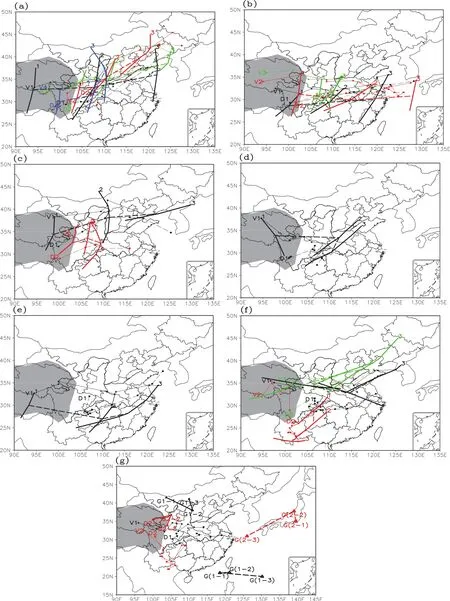
Fig.9.Synoptic system sketchmap of similarmovement tracksof TVSPDVsand TVSWVs.TVSPDVsaredenoted by closed circles,TVSWV by closed squares,and the trough line or shear line by the thick solid line.The central points of the trough line or shear line are linked by thick dashed linesw ith the time numbers 1,2 or 3 on its rightside of the line’sbeginning.In two vorticesw ith the samemovementdirection,the1,2 and 3 indicate the beginning,middle and end times.In two vorticesw ith changedmovementdirection,the 1,2 and 3 indicate the beginning,turning direction and end time.High-pressure centers are denoted by the capital letter“G”.(a)Moving northeastward along w ith the 500 hPa trough.(b)Moving eastward along w ith the 500 hPa trough.(c)Moving northeastward along w ith the 500 hPa trough and then changing to southeastward.(d)Moving southeastward along w ith the 500 hPa trough and then changing southwestward.(e)Moving southeastward alongw ith the500 hPa trough and then changing northeastward. (f)Moving along w ith the 500 hPa shear line.(g)Moving in the 500 hPa sheared field.The shading is the same as in Fig.2.
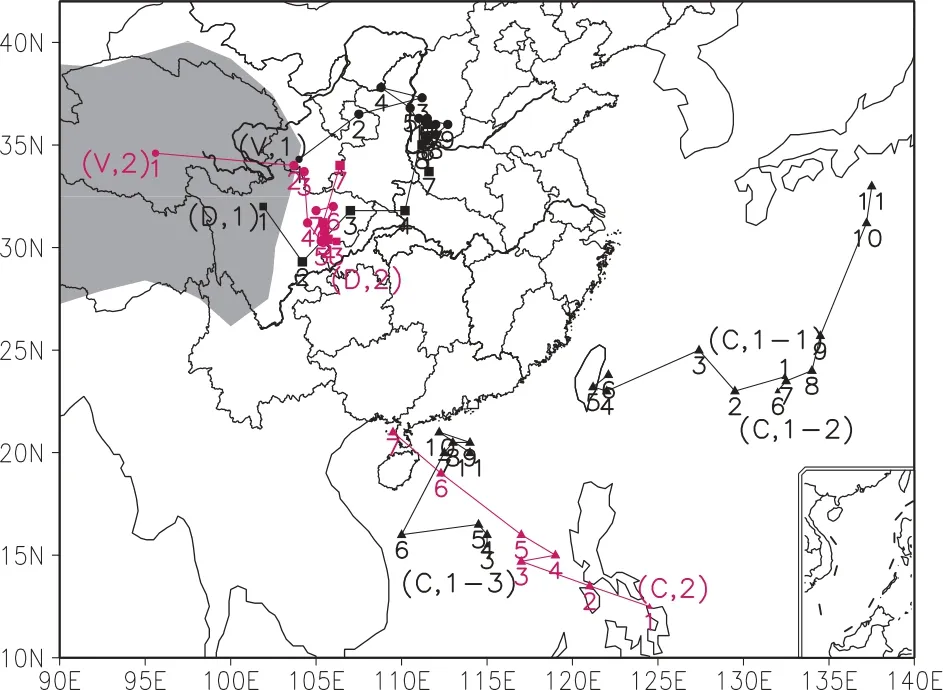
Fig.10.Paths of tropical lowsand the simultaneously spinning TVSPDVs and TVSWVs.The“V”denotes TVSPDVs,while“D”denotes TVSWVs and“C”denotes tropicalpressure lows. Theshading is the sameas in Fig.2.
Table 5 compares the characteristics of TVSPDVs and SDPVsin differentaspects,suchastheactiveperiod,sources, paths,thermodynam ic properties,leading synoptic system, and path alteration;and Table 6 does the same but for TVSWVs and SWVs.It can be seen from Tables 5 and 6 that TVSPDVs(TVSWVs)are totally different from SDPVs (SWVs).It is interesting to note that,w ith the presence of a tropical low pressuresystem over thesea to theeastand south of China,TVSPDVs and TVSWVs have a higher chance to recurve over the same area simultaneously,and tomove southward together due to the tropical low near Hainan Island.
6. Conclusions
(1)TVSPDVsand TVSWVsare dynam ically active from May to August,w ithmostoccurrences in Juneand July.
(2)Themain vortex source of TVSPDVs is near Zaduo, then near Yushu and Qumalai;and theprimary vortex source of TVSWVs is in Jiulong,then in Daocheng,Quxian and Tongnan.
(3)In most cases,TVSWVs possess sim ilarmovement directions as TVSPDVs,moving eastward together w ith the eastward-moving low trough.Meanwhile,TVSPDVs dom inantly move in the area to the north of the Yangtze River,while TVSWVs are active in the Yangtze River valley.
(4)TVSPDVs and TVSWVs are important factors leading to sustained regional rainstorms in China,especially to thesouthof theYellow River.Their impactmay reachamuch w iderarea of China,andmay even affect theweatheron the Korean Peninsula,in Japan,and Vietnam.
(5)TVSPDVs and TVSWVs alter their intensities and thermodynamic properties during their movement.Most TVSPDVs and all TVSWVs are baroclinic or cold and can be strengthened,leading to extremely heavy rainfall,downpours,or sustained regional rainstorms.
(6)Some TVSPDVs and TVSWVsmay move over the seaand become strengthened,with enhanced rainfalland declined geopotentialheight,especially TVSWVs.
(7)TVSPDVs and TVSWVsm ight spin over the same area simultaneously as a result of the influence of remote tropical cyclonic activity.The tropical low near Hainan Island can push TVSWVsand TVSPDVs southward together.

Table 5.The characteristicsof TVSPDVsand SDPVs.

Table 6.The characteristicsof TVSWVsand SWVs
APPENDIX
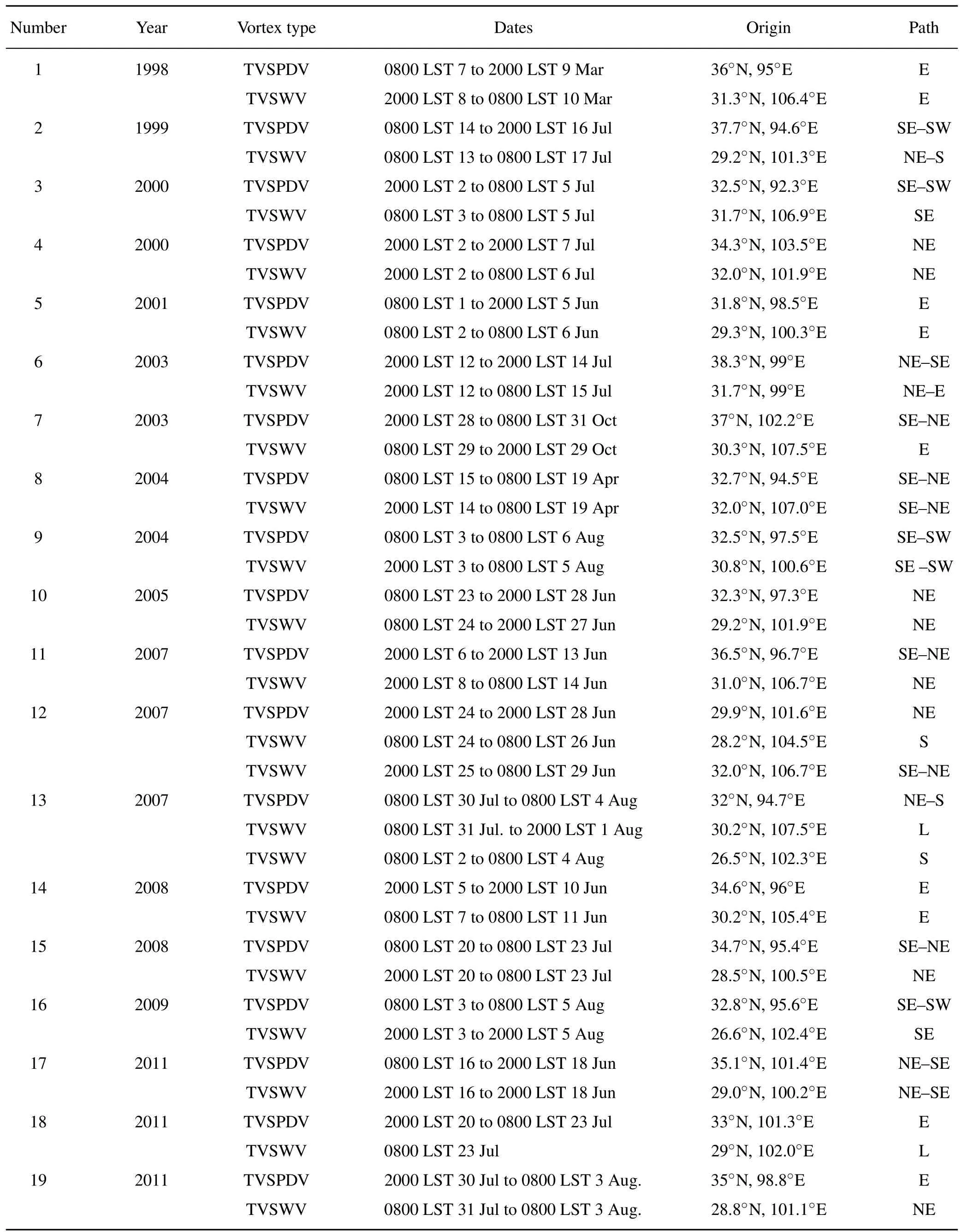
Summary of the TVSPDV and TVSWV activities from 1998 to 2013
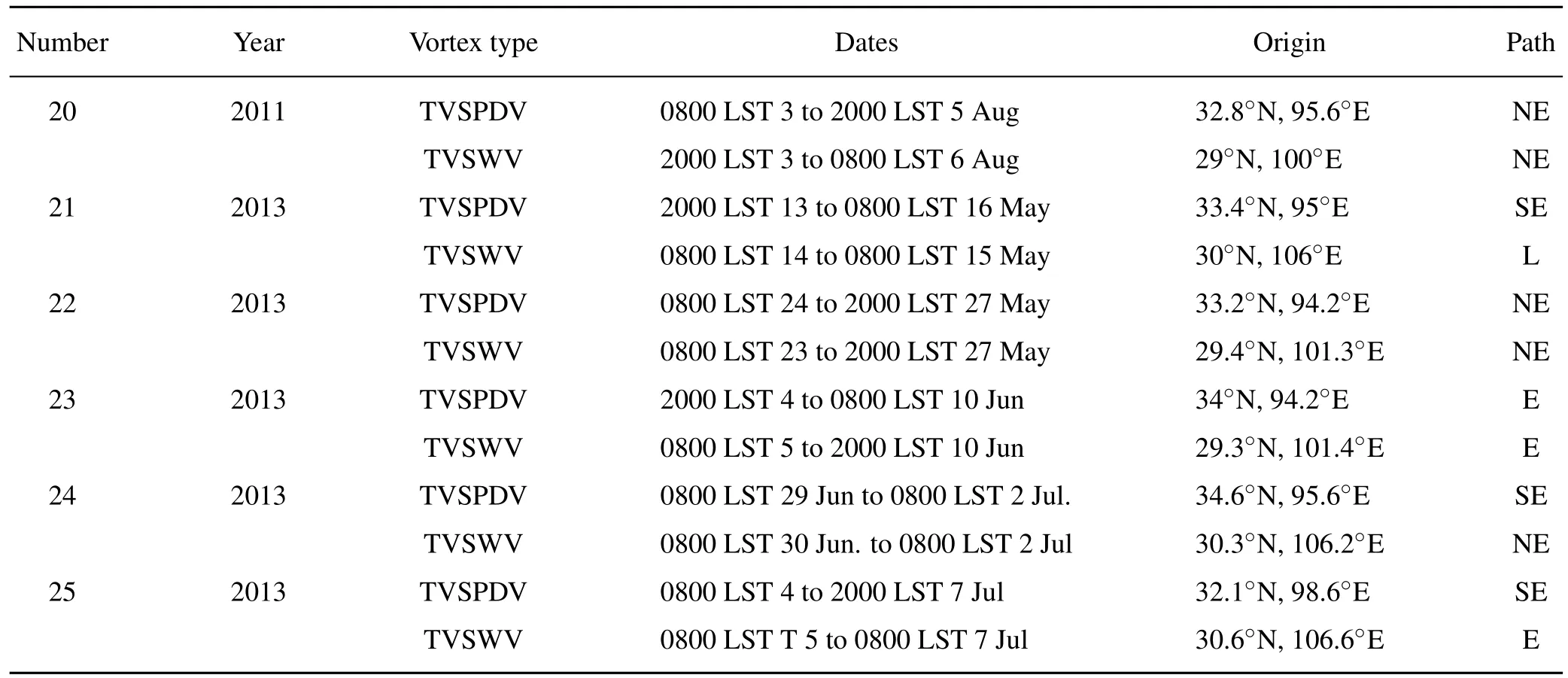
(continued)
Acknow ledgements.We thank the two anonymous reviewers for their commentsand suggestions,which greatly helped us to improve the presentation of the paper.Thanks to Hua LIU,Leiau LUO and Xingwen JIANG for helping on the translation of some part of this paper.This research was supported by project funds from the National Natural Science Foundation of China(Grant Nos.91332715 and 41275052)and the National Key Foundation Development Study Developing(973)Programme(Grant No. 2012CB417202).
REFERENCES
Chang,C.P.,L.Yi,and G.T.J.Chen,2000:A numericalsimulation of vortex developmentduring the 1992 East Asian summermonsoon onsetusing Navy’s regionalmodel.Mon.Wea. Rev.,128,1604–1631.
Chen,D.,Y.Q.Li,and R.H.Huang,2007a:The physicalprocess analyses of the southwest vortex development and its effect on heavy rainfall in eastern Sichuan under the saddle pattern background of largescale circulations.Chinese J.Atmos.Sci., 31,185–201.(in Chinese)
Chen,L.S.,J.X.Ma.,and Z.X.Luo,2000:A Prelim inary study on themovement of vortex over the orography.The Second Theoretic Research Advance ofTibetan Plateau Atmosphere III.Tao etal.,Eds.,ChinaMeteorologicalPress,Beijing,90–97.(in Chinese)
Chen,L.F.,K.Gao,and Y.M.Xu,2004:Relationship between the evolvementof Meiyu frontand the vortex along it.JournalofZhejiang University(Science Edition),31,103–109.(in Chinese)
Chen,Q.Z.,Y.W.Huang,Q.W.Wang,and Z.M.Tan,2007b: The statistical study of the southwest vortexes during 1990–2004.Journal ofNanjing University(Natural Sciences),43, 633–642.(in Chinese)
Chen,Z.M.,1990:A dynam ic mechanism of on the formation and developmentof the southwestvortex.JournalofSichuan Meteorology,10(4),1–8.(in Chinese)
Chen,Z.M.,and W.B.Min,1999:Statistical study on activity of southwestvortex.Advances in TheoreticalResearch on the Second Atmosphere Scientific Experiments over the Qinghai-Xizang Plateau II.Tao et al.,Eds.,China Meteorological Press,Beijing,368–378.(in Chinese)
Chen,Z.M.,M.L.Xu,W.B.Min,and Q.Miao,2003:Relationship between abnormalactivitiesof southwestvortex and heavy rain the upper reach of Yangtze River during summer of 1998.Plateau Meteorology,22,162–167.(in Chinese)
Chen,Z.M.,W.B.Min,and C.G.Cui,2007c:Diagnostic analysis on the formation and developmentofmeso-scale vortex systems.TorrentialRain and Disasters,26,29–34.(in Chinese)
Gao,S.T.,1987:The dynam ic action of thedisposition of the fluid field and the topography on the formation of the southwest vortex.Chinese J.Atmos.Sci.,11,263–271.(in Chinese)
He,G.B.,W.L.Gao,and N.N.Tu,2009:The dynam ic diagnosis on easterwardsmoving characteristicsand developingmechanism of two Tibetan Plateau vortex processes.Acta Meteorologica Sinica,67,599–612.(in Chinese)
Institute of Plateau Meteorology,China Meteorological Adm inistration,Chengdu,and Plateau Meteorology Comm ittee of Chinese Meteorological Society,2013:Southwest Vortex Yearbook in 2012.China Science Press,Beijing,352 pp.(in Chinese)
Kuo,Y.H.,L.S.Cheng,and J.W.Bao,1988:Numerical simulation of the 1981 Sichuan flood.Part l:Evolution of a mesoscale southwest vortex.Mon.Wea.Rev.,116,2481–2504.
Li,G.P.,J.Wan,and J.H.Lu,1991:A potentialmechanism of the warm vortex genesis in southwest China.Quarterly Journal ofApplied Meteorology,2,91–99.(in Chinese)
Li,G.P.,X.P.Luo,T.Chen,and G.Chen,2011:Preliminary theoreticalstudy ofwaves in the Tibetan Plateau vortex.Plateau Meteorology,30,553–558.(in Chinese)
Lu,J.H.,1986:An Introduction to SouthwestChina Vortex.China Meteorological Press,Beijing,276 pp.(in Chinese)
Luo,S.W.,1992:The Researches of Several Synoptic Systems ofTibetan Plateau and Nearby Areas.China Meteorological Press,Beijing,205 pp.(in Chinese)
Qian,Z.A.,F.M.Shan,J.L.Nu,Y.X.Cai,and Y.C.Chen,1984: The discusson climate factorsand statistic analysisof the Tibetan Plateau vortex in summer 1979.The Tibetan Plateau Meteorological ExperimentCorpus II.EditGroup of Tibetan Plateau Meteorological ExperimentCorpus,Eds.,China Scientific Press,Beijing,182–194.(in Chinese)
Song,W.W.,G.P.Li,and Q.K.Tang,2012:Numerical simulation of the effect of heating and water vapor on two cases of Plateau vortex.Chinese J.Atmos.Sci.,36,117–129.(in Chinese)
Takahashi,H.,2003:Observational study on the initial formation process of the Mei-yu frontal disturbance in the eastern foot of the Tibetan Plateau in m iddle–late June 1992.J.Meteor. Soc.Japan,81,1303–1327.
Tao,S.Y.,and Y.H.Ding,1981:Observational evidence of the influenceof theQinghai-Xizang(Tibet)Plateau on theoccurrence of heavy rain and severe convective storms in China. Bull.Amer.Meteor.Soc.,62,23–30.
Wang,B.,1987:The developmentmechanism for Tibetan Plateau warm vortices.J.Atmos.Sci.,44,2978–2994.
Wang,X.,Y.Q.Li,S.H.Yu,and X.W.Jiang,2009:Statistical study on the plateau low vortex activities.Plateau Meteorology,28,64–71.(in Chinese)
Wang,Z.,and K.Gao,2003:Sensitivity Experiments of an eastward-moving southwest vortex to initial perturbations. Adv.Atmos.Sci.,20,638–649.
Ye,D.Z.,and Y.X.Gao,1979:Meteorology of The Tibetan Plateau.China Scientific Press,Beijing,278 pp.(in Chinese) Yu,S.H.,and W.L.Gao,2006:The observational facts analysis of vortexmoving outof The Tibetan Plateau.Acta Meteorologica Sinica,64,392–399.(in Chinese)
Yu,S.H.,W.L.Gao,and Y.H.Xiao,2008:Analysis for the influence of cold airmass on two cases of plateau vortexmoving outof the Tibetan plateau.Plateau Meteorology,27,96–103. (in Chinese)
Yu,S.H.,and W.L.Gao,2009:Large-scale conditions of Tibet Plateau vortex departure.Sciences in Cold and Arid Regions, 1,559–569.
Yu,S.H.,W.L.Gao,J.Peng,and Y.H.Xiao,2014:Observational facts of sustained departure Plateau vortexes.J.Meteor.Res., 28,296–307.
Zhang,S.L.,S.Y.Tao,Q.Y.Zhang,and X.L.Zhang,2001:Meteorologicaland Hydrological characteristicsof severe flooding in China during the summer of 1998.Quarterly Journal ofApplied Meteorology,12,442–457.(in Chinese)
Zhou,G.B.,T.L.Shen,and Y.Han,2006:A numerical simulation and diagnoses case analysis of typhoon affecton southwestvortex.Scientia Meteorologica Sinica,26,620–626.(in Chinese)
5 February 2015;revised 12 June 2015;accepted 16 June 2015)
:Yu,S.H.,W.L.Gao,D.X.Xiao,and J.Peng,2016:Observational facts regarding the joint activities of the southwest vortex and plateau vortex after its departure from the Tibetan Plateau.Adv.Atmos.Sci.,33(1),34–46,
10.1007/s00376-015-5039-1.
∗Corresponding author:Shuhua YU
Email:scshuhuayu@163.com
杂志排行
Advances in Atmospheric Sciences的其它文章
- Variation in Summer Surface Air Tem perature over Northeast Asia and Its Associated Circulation Anomalies
- Ensemble Transform Sensitivity Method for AdaptiveObservations
- Dynam ic and Thermodynam ic Featuresof Low and Midd le Clouds Derived from Atmospheric Radiation Measurement Program Mobile Facility Radiosonde Data at Shouxian,China
- Teleconnected Influenceof the BorealW inter Antarctic Oscillation on the Somali Jet:Bridging Role of Sea Surface Tem perature in Southern High and Midd le Latitudes
- Effectsof Surface Flux Parameterization on the Numerically Simulated Intensity and Structureof Typhoon Morakot(2009)
- Verification and Correction of Cloud Base and Top Height Retrievals from Ka–band Cloud Radar in Boseong,Korea
